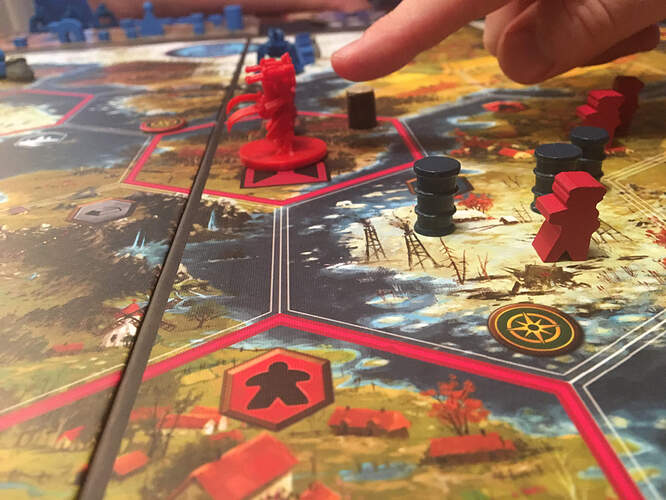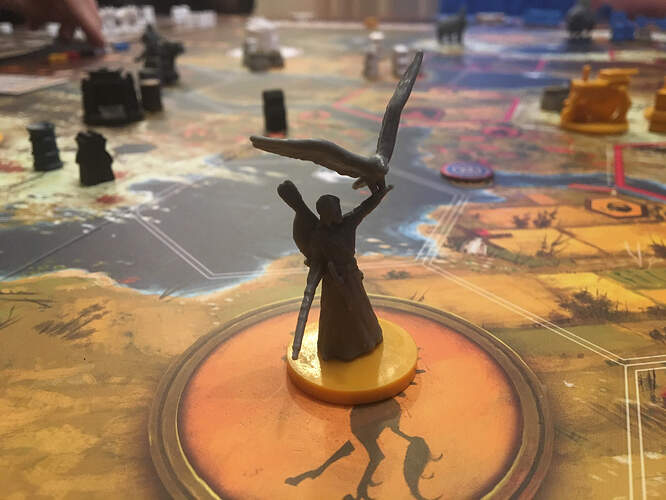Originally published at: http://statelyplay.com/2017/04/04/cardboard-critique-scythe/
The board game Scythe has had its share of space here on Stately Play due to the fact that a digital version is in the works and should be coming sometime in 2017. It never really dawned on me that the rest of you aren’t spending half your waking hours skimming game info over at BoardGameGeek, or lurking on Kickstarter waiting for The Next Big Thing to arrive in board games. I just assumed that you’d be as excited for a digital Scythe as I was. Let’s talk about the tabletop game a bit, and maybe you’ll see where the excitement is coming from.
Scythe is the brainchild of Jamey Stegmaier of Stonemaier Games and came to life via an infusion of cash from Kickstarter. A nearly $2 million infusion of cash. There was a lot of hype surrounding Scythe before, during, and after its Kickstarter campaign, and rightly so. Here was a game that offered a deep euro experience, but also had giant robots on the board. Euro gamers and Ameritrashers both had reasons to be excited.
The hype continued to its release last year. I worked at the BGG New Game Room at Gen Con last year and Scythe was always on the table. In fact, it was the only title that we needed to create a waiting list for. Positive reviews started flowing in, and Scythe now rests in the top ten games of all time at BGG.
Despite it’s hexes and mechs, Scythe is primarily a euro game. The goal is to accumulate the most money by game’s end, and you do this by collecting resources and turning those resources into other things. Iron can be turned into more mechs, wood it used to construct buildings, oil is used to upgrade actions and become more efficient, and grain is used to enlist more units. There are also resources like Popularity and Power that are recorded on tracks printed on the game board. Power helps in combat, while a higher Popularity will help you make more money when the game ends.
[caption id=“attachment_1680” align=“aligncenter” width=“4032”]
Its bark is worse than its bite.[/caption]Unlike other euros in which you produce and collect your resources, hoarding them in front of you, Scythe has you keeping all resources on the board. To spend them, you must control the space where the resources are present, meaning you need to have a unit in that hex. This also means that someone else can move into a space with resources you produced, and now those resources no longer belong to you. It’s as cool as it sounds.
Getting resources (and doing anything else) requires taking actions. Each player has a board divided into four sections, each one detailing a specific action and its cost. Each section has both a “top” action and a “bottom” action. The top action must be performed and involves things like producing resources where you have workers, moving your mechs and workers, spending money to buy goods you can’t produce, or increasing your military strength by bumping up your Power resource. The bottom actions are what I mentioned above: spending iron to build mechs, etc.
The trick is that you select an action with a pawn, and then are unable to select that action the next turn. You must move your pawn to another space, meaning you can’t spam resource production or moving your units (with one exception…I’ll get to that in a bit). In terms of realism, it’s not a perfect system (why can’t I move my units twice in a row?), but it’s better than something like Agricola where no one else can take a resource or action because you got there first.
Turns are extremely quick, with usually only one quick action being the norm. Occasionally, you’ll have a little longer bit when someone has to take one of those bottom actions, but the next player can start their turn while that bottom action is getting figured out. Thus, even a five player game has fairly little downtime and even 3-4 hour games can fly by.
[caption id=“attachment_1681” align=“aligncenter” width=“4032”]
Other factions have bears and tigers. I get a pigeon.[/caption]There’s one track printed on the board that I’ve neglected to mention, and that’s where you put your Stars. Every player begins with six stars and when anyone places their sixth, the game ends. Stars are placed for completing achievements such as placing all eight of your workers on the board, or building all four of your mechs. You’ll get a star for building all four of your buildings, or winning up to 2 combats. There are a lot of ways to place stars and, unless you’re in the lead, you will not want that 6th star placed, causing you to change your strategy and focus on area where you aren’t close to earning your last star or, more likely, stopping someone else from playing one of theirs. It’s basically the achievement system present in so many video games, and it works great. I can’t think of another game that uses a system like this to keep track of game length, and I really like it.
Combat is actually the weakest aspect of the game, based on a blind bidding system. You’re allowed to spend up to seven Power (remember that track?) as well as play a Battle Card for each unit you have in a fight. These values are secretly selected and revealed with the higher value winning the fight. It’s a simple system that is somewhat anticlimactic considering you’re clashing with mechs that tower over the board. That said, there’s strategy baked into the system mainly due to the fact that losing a fight isn’t the worst thing in the world. Units don’t die, but shuffle off to your starting hex where you can redeploy them. Also, the winner will lose Popularity for every worker that is sent back home, which makes conquering resource rich territories costly. Also, spending power and being low on that Power track means you’re a target. You can definitely fall into the old cliche about winning the battle but losing the war. Most factions only get stars for winning up to two combats in the game as well, so winning more than two combats isn’t usually worth it unless you have a lot of resources on the line.
There are five different factions (seven if you have the expansion) and each has their own game-breaking ability. Some seem much more useful than others, but I’ve only had four plays of the game so I’m not quite ready to say anything is broken or overpowered. One faction can take the same action over and over again each turn, one can get stars for more than 2 combats. You get the idea. Each faction also gets special powers when they build mechs, and these can be different for each faction as well. For example, one faction’s mechs can act as submarines and teleport around the board from lake to lake, which are spaces that no other faction can travel in. In all, there’s a lot of mixing and matching between these powers and, while I find some of them frustrating, especially when I don’t have them, finding combos or using powers the other players don’t have is a big part of the fun.
There’s more. We haven’t touched on how mechs are necessary even for pacifists because only mechs can cross rivers. They can carry workers with them, so if you want to spread out (and you will) you’ll need mechs to carry workers around the board. We haven’t talked about The Factory, which is the center space of the board and will offer players who get their unit there a new action they can add to their player board that will be unique to their faction for the remainder of the game. We haven’t talked about how the four buildings you can build allow you to break certain rules by teleporting units to other spaces across the board, or will earn you resources even without workers. There are events you can find which offer a Choose-Your-Own-Adventure style choice that will always be a benefit to your faction. There’s a lot going on in Scythe, but it all fits in context with the theme of the game.
Quite possibly the best part of Scythe is its graphic design. Each player board is exquisite in both art and utility. Cubes fit precisely in spaces and reveal new powers or costs when moved. Buildings each have their own slot on the board, and reveal their power when removed and placed on the board. They are, quite possibly, the best player boards I’ve ever seen in a cardboard title. The genius extends to the board and miniatures as well. Each hex on the board is clearly labeled with its resource icon, so you’re not left wondering if that’s a mountain or a village space. End game scoring is laid out next to the Popularity track so you can clearly see how much money everyone will be earning at the end of the game. Workers are wooden, mechs and your character units are plastic. Only plastic pieces combat, so you can easily spot when combat is likely and how many units it will involve without having to dig through a forest of different shaped meeples. While there are a lot of rules, the boards and pieces remind you of how things work, making rulebook lookups a rarity during gameplay.
If you haven’t noticed, I like Scythe quite a bit. I will say that, while special abilities can be shuffled around between games, the maps and starting locations all remain the same and games can seem a bit samey. Not that they’re not fun, but the games we’ve played have all had the same rhythms. This happens with a lot of games, and isn’t necessarily a burn. Hell, every game of Brass I’ve ever played has the same beats as well, and I’ll never turn down a game of Martin Wallace’s classic. So, why bring it up? I’m digging for any negatives I can, and I’m having a hard time. Really, the only downside I can think of comes if you were going in looking for a regular DoaM game with a lot of dice rolls, trading territory, and a body count. If you don’t mind a very little trash in your euros, then Scythe should be right up your alley.


